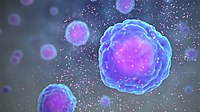
Photo from wikipedia
Severe injury is known to cause a systemic cytokine storm that is associated with adverse outcomes. However, a comprehensive assessment of the time-dependent changes in circulating levels of a broad… Click to show full abstract
Severe injury is known to cause a systemic cytokine storm that is associated with adverse outcomes. However, a comprehensive assessment of the time-dependent changes in circulating levels of a broad spectrum of protein immune mediators and soluble immune mediator receptors in severely injured trauma patients remains uncharacterized. To address this knowledge gap, we defined the temporal and outcome-based patterns of 184 known immune mediators and soluble cytokine receptors in the circulation of severely injured patients. Proteomics (aptamer-based assay, SomaLogic, Inc) was performed on plasma samples drawn at 0, 24, and 72 hours (h) from time of admission from 150 trauma patients, a representative subset from the Prehospital Plasma during Air Medical Transport in Trauma Patients at Risk for Hemorrhagic Shock (PAMPer) trial. Patients were categorized into outcome groups including Early Non-Survivors (died within 72 h; ENS; n=38), Non-Resolvers (died after 72 h or required ≥7 days of intensive care; NR; n=78), and Resolvers (survivors that required < 7 days of intensive care; R; n=34), with low Injury Severity Score (ISS) patients from the Tranexamic Acid During Prehospital Transport in Patients at Risk for Hemorrhage After Injury (STAAMP) trial as controls. The major findings include an extensive release of immune mediators and cytokine receptors at time 0h that is more pronounced in ENS and NR patients. There was a selective subset of mediators elevated at 24 and 72 h to a greater degree in NR patients, including multiple cytokines and chemokines not previously described in trauma patients. These findings were validated in a quantitative fashion using mesoscale discovery immunoassays (MSD) from an external validation cohort (VC) of samples from 58 trauma patients matched for R and NR status. This comprehensive longitudinal description of immune mediator patterns associated with trauma outcomes provides a new level of characterization of the immune response that follows severe injury.
Journal Title: Frontiers in Immunology
Year Published: 2022
Link to full text (if available)
Share on Social Media: Sign Up to like & get
recommendations!